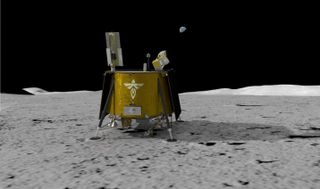NASA picks Firefly Aerospace to deliver science payloads to the moon in 2023
Firefly's robotic Blue Ghost lander will carry 10 experiments and technology demonstrations.

A Firefly Aerospace lander will launch to the moon in 2023 as part of NASA's Artemis program.
NASA selected Texas-based Firefly Aerospace to deliver 10 scientific experiments and technology demonstrations to the lunar surface in 2023. The company's robotic Blue Ghost lander will touch down in a lunar mare called Mare Crisium, which is a low-lying basin on the near side of the moon that measures more than 300 miles (480 kilometers) wide.
The lander will carry instruments to study several aspects of the lunar surface in preparation for future human missions to the moon, according to a NASA statement.
Moon rush: Private lunar lander plans
The $93.3 million contract awarded to Firefly Aerospace is part of NASA’s Commercial Lunar Payload Services (CLPS) initiative, which seeks commercial partners to land science and technology payloads on the lunar surface. The Firefly Aerospace contract is the sixth award for lunar surface delivery under CLPS, which is an important part of the agency’s Artemis program of crewed lunar exploration.
"We’re excited another CLPS provider has won its first task order award. With this initiative, we seek to develop ways for new science and technology development utilizing a service-based model," Thomas Zurbuchen, associate administrator for science at NASA, said in the statement. "This allows U.S. vendors to not only demonstrate their ability to safely deliver payloads to our celestial neighbor, but also expand this capability for others who want to take advantage of this cutting-edge approach to explore the moon."
Under the new contract, Firefly Aerospace will be responsible for end-to-end delivery services, including payload integration, launching from Earth, landing on the moon and mission operations.
Get the Space.com Newsletter
Breaking space news, the latest updates on rocket launches, skywatching events and more!
Firefly is honored to be awarded a $93.3M contract by NASA to deliver ten NASA-sponsored science and technology payloads to the lunar surface using our Blue Ghost lunar lander!https://t.co/epvsZswOrjFebruary 4, 2021
Blue Ghost will carry 10 instruments that will investigate various features of the moon, including fragmented rock and soil — also known as regolith — on the lunar surface, the structure and composition of the moon’s mantle and the heat flow at different depths beneath the lunar surface. Other scientific experiments will measure the precise distance between Earth and the moon, study the interaction of solar wind and Earth’s magnetic field and investigate the impact of solar radiation on the lunar surface, NASA officials said.
The lander will also carry an instrument called the Lunar PlanetVac, which is designed to collect regolith from the lunar surface that could be returned to Earth as part of a separate mission, and the Lunar GNSS Receiver Experiment, which will test the ability to use GPS signals at lunar distances. Collectively, the 10 research payloads are expected to weigh 207 lbs. (94 kilograms), according to the statement from NASA.
"The payloads we’re sending as part of this delivery service span across multiple areas, from investigating the lunar soil and testing a sample-capture technology, to giving us information about the moon’s thermal properties and magnetic field," Chris Culbert, manager of the CLPS initiative at NASA’s Johnson Space Center in Houston, said in the statement.
Blue Ghost, named after a rare species of firefly, will also be equipped with stereo cameras designed to capture video and still images of the area under the spacecraft, to better understand how the lander’s exhaust disrupts the lunar surface.
Follow Samantha Mathewson @Sam_Ashley13. Follow us on Twitter @Spacedotcom and on Facebook.
Join our Space Forums to keep talking space on the latest missions, night sky and more! And if you have a news tip, correction or comment, let us know at: community@space.com.

Samantha Mathewson joined Space.com as an intern in the summer of 2016. She received a B.A. in Journalism and Environmental Science at the University of New Haven, in Connecticut. Previously, her work has been published in Nature World News. When not writing or reading about science, Samantha enjoys traveling to new places and taking photos! You can follow her on Twitter @Sam_Ashley13.
